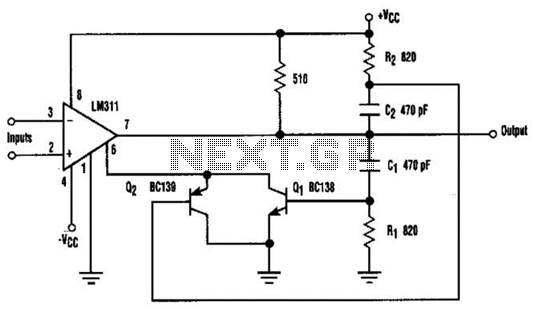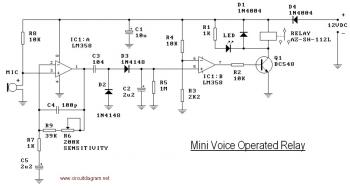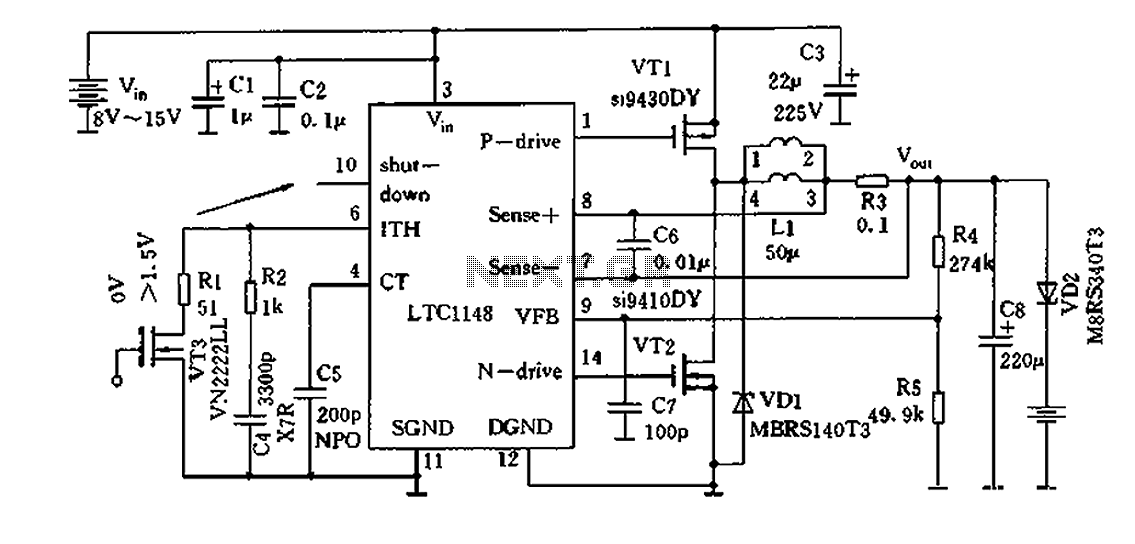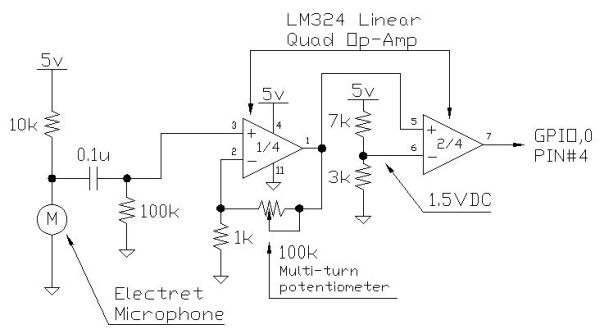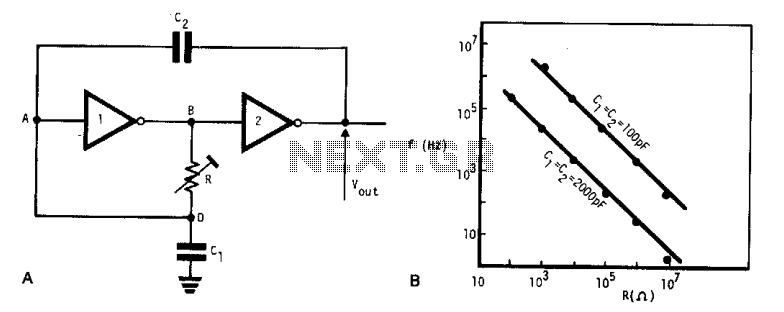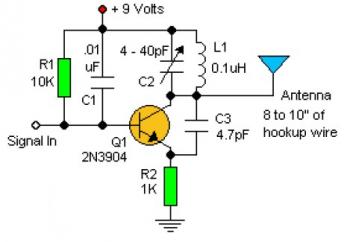
Digital precision pressure tester circuit integrated precision pressure signal conditioner MAX1457
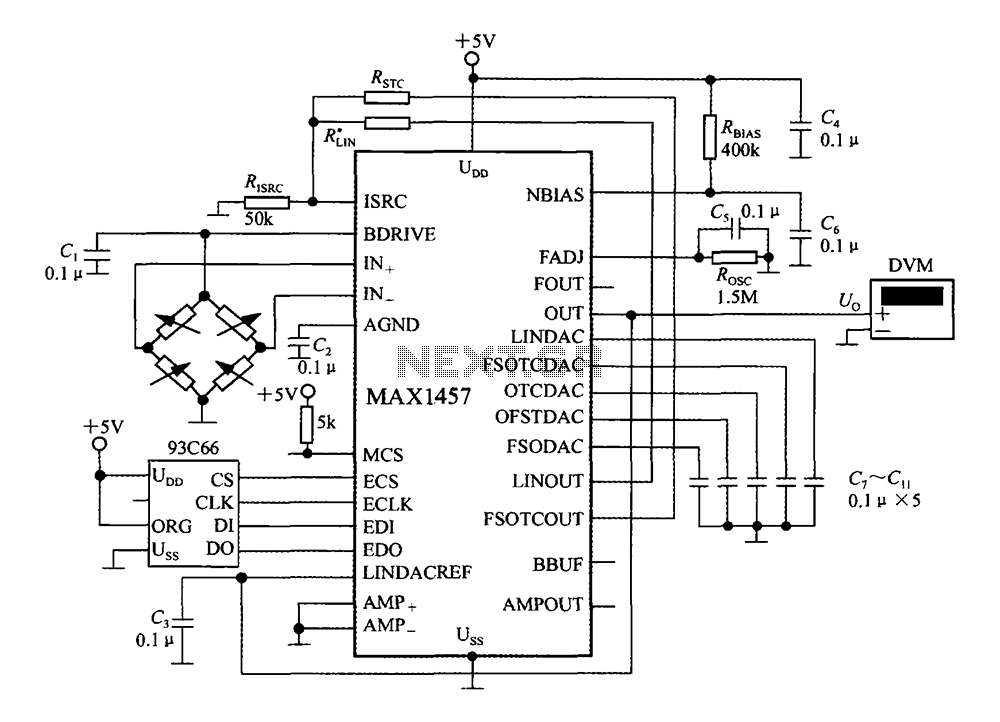
The circuit diagram illustrates a digital precision pressure tester using the MAX1457 integrated circuit with an external ROM selection of the 93C66 type, which is a 4096-bit E2PROM. Upon powering on, the MCS pin is pulled to a high level to initiate the circuit. A +5V power supply is connected through a resistor (RBIAS) valued at 400k ohms, which provides the necessary bias voltage for the bias circuit. Capacitors C2, C4, and C6 serve as decoupling capacitors, while capacitors C1, C3, C5, C7 through C11 function as bypass capacitors. With a resistor value of RISRC set to 50k ohms, the excitation current is maintained at 0.5mA. The RSTC resistor is utilized for full-scale temperature coefficient compensation, while the R*LIN resistor is designated for non-linear calibration (although it cannot be adjusted). The pressure signal generated by the sensor is processed by the MAX1457 and output from the OUT terminal to a digital voltmeter (DVM), which displays the measured pressure values.
The digital precision pressure tester circuit is designed to provide accurate pressure measurements through a systematic approach involving various components. The MAX1457 serves as the core of the circuit, integrating functions necessary for processing pressure signals. The selection of the 93C66 E2PROM allows for external memory capabilities, facilitating the storage of calibration data and other essential parameters.
The circuit is powered by a stable +5V supply, ensuring consistent performance. The 400k ohm RBIAS resistor is critical in establishing the appropriate bias voltage, which is essential for the proper operation of the bias circuit. Decoupling capacitors C2, C4, and C6 are strategically placed to filter out high-frequency noise, maintaining signal integrity throughout the circuit. Bypass capacitors C1, C3, C5, C7 through C11 further enhance stability by providing localized energy storage, thus ensuring that the voltage levels remain stable during operation.
The excitation current of 0.5mA, established by the 50k ohm RISRC resistor, is vital for the sensor's operation, as it determines the sensitivity and response time of the pressure measurement. The RSTC resistor plays a crucial role in compensating for temperature-induced variations in the full-scale output, thus enhancing the accuracy of the readings across different environmental conditions. Meanwhile, the R*LIN resistor, although not adjustable, is essential for addressing non-linearities in the sensor's output, ensuring that the pressure values displayed on the DVM are as precise as possible.
The output from the MAX1457 is directed to a digital voltmeter, which translates the processed pressure signal into a readable format. This setup allows for real-time monitoring of pressure values, making it suitable for various applications in industrial and laboratory settings where precision is paramount. Overall, the design of this digital precision pressure tester circuit reflects a comprehensive understanding of electronic principles and component functionality, resulting in an effective solution for pressure measurement.Digital precision pressure tester circuit shown in Fig. MAX1457 external ROM selection 93C66 type 4096b E2PROM. After power MCS end is pulled to a high level, check the main ch ip. + 5V power supply through a resistor RBIAS (400k ) provide appropriate bias voltage to the bias circuit. C2, C4 and C6 are decoupling capacitors. C1, C3, C5, C7 ~ C11 are bypass capacitors. When taking RISRC 50k, excitation current 0.5mA. RSTC full scale temperature coefficient compensation resistor, R * LIN non-linear calibration resistor (can not).
Pressure signal generated by the sensor after MAX1457 processing output from OUT terminal to the digital voltmeter (DVM), shows the measured pressure values.
The digital precision pressure tester circuit is designed to provide accurate pressure measurements through a systematic approach involving various components. The MAX1457 serves as the core of the circuit, integrating functions necessary for processing pressure signals. The selection of the 93C66 E2PROM allows for external memory capabilities, facilitating the storage of calibration data and other essential parameters.
The circuit is powered by a stable +5V supply, ensuring consistent performance. The 400k ohm RBIAS resistor is critical in establishing the appropriate bias voltage, which is essential for the proper operation of the bias circuit. Decoupling capacitors C2, C4, and C6 are strategically placed to filter out high-frequency noise, maintaining signal integrity throughout the circuit. Bypass capacitors C1, C3, C5, C7 through C11 further enhance stability by providing localized energy storage, thus ensuring that the voltage levels remain stable during operation.
The excitation current of 0.5mA, established by the 50k ohm RISRC resistor, is vital for the sensor's operation, as it determines the sensitivity and response time of the pressure measurement. The RSTC resistor plays a crucial role in compensating for temperature-induced variations in the full-scale output, thus enhancing the accuracy of the readings across different environmental conditions. Meanwhile, the R*LIN resistor, although not adjustable, is essential for addressing non-linearities in the sensor's output, ensuring that the pressure values displayed on the DVM are as precise as possible.
The output from the MAX1457 is directed to a digital voltmeter, which translates the processed pressure signal into a readable format. This setup allows for real-time monitoring of pressure values, making it suitable for various applications in industrial and laboratory settings where precision is paramount. Overall, the design of this digital precision pressure tester circuit reflects a comprehensive understanding of electronic principles and component functionality, resulting in an effective solution for pressure measurement.Digital precision pressure tester circuit shown in Fig. MAX1457 external ROM selection 93C66 type 4096b E2PROM. After power MCS end is pulled to a high level, check the main ch ip. + 5V power supply through a resistor RBIAS (400k ) provide appropriate bias voltage to the bias circuit. C2, C4 and C6 are decoupling capacitors. C1, C3, C5, C7 ~ C11 are bypass capacitors. When taking RISRC 50k, excitation current 0.5mA. RSTC full scale temperature coefficient compensation resistor, R * LIN non-linear calibration resistor (can not).
Pressure signal generated by the sensor after MAX1457 processing output from OUT terminal to the digital voltmeter (DVM), shows the measured pressure values.
Warning: include(partials/cookie-banner.php): Failed to open stream: Permission denied in /var/www/html/nextgr/view-circuit.php on line 713
Warning: include(): Failed opening 'partials/cookie-banner.php' for inclusion (include_path='.:/usr/share/php') in /var/www/html/nextgr/view-circuit.php on line 713
